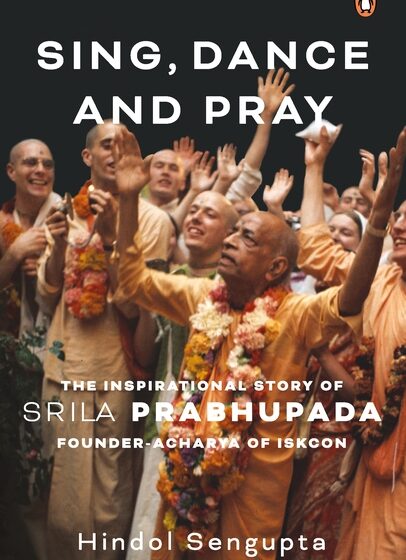Inspiring life of ISKCON Founder Srila Prabhupada

Team L&M
Penguin Random House India has come out with a biography of Founder-Acharya of ISKCON Srila Prabhupada. The book Sing, Dance, and Pray: The Inspirational Story of Srila Prabhupada is written by by Hindol Sengupta. Released today, it is an inspirational story of Srila Prabhupada who emerged as a major figure of Western counterculture, introducing ancient teachings of Vedic India to mainstream America in the mid 20th century attracting everyone from Allen Ginsberg to George Harrison, and millions of followers in more than 100 countries. A fascinating read, the book brings aliv
Go through a little excerpt (page 3-5) to know what this book is all about:
Summer 1967.
Soon after leaving San Francisco, the Learjet seemed like it might crash.
It wobbled, sputtered and rolled in the air. On the aircraft sat a man, whispering to himself. If he died that day, his death would create headlines around the world, and a tidal wave of grief from beleaguered fans. Few artistes before or after him have attained the fame that he had already seen with his band. He was a millionaire many times over.
As he sat in that plane, George Harrison, famed singer- songwriter, instrumentalist and one of the ‘Fab Four’ of The Beatles, faced with the possibility of his death, chanted again and again, Hare Krishna, Hare Krishna, Krishna Krishna, Hare Krishna, Hare Krishna, Krishna Krishna, Hare Hare/ Hare Rama, Hare Rama, Rama Rama, Hare Hare. This was not unusual.
Only a few days ago, Harrison had spent six hours in a boat with his fellow Beatle, John Lennon, floating by the waters near Greece, all the while playing a ukulele and singing, again and yet again, Hare Krishna, Hare Krishna, Krishna Krishna, Hare Hare/ Hare Rama, Hare Rama, Rama Rama, Hare Hare.
Was one of the world’s most famous singers of all time chanting the Krishna mantra in joy, down the Aegean in a boat, or in mortal fear, in a plane tottering in the skies above San Francisco?
By 1967, The Beatles were the world’s most famous musical group, on their way to becoming the biggest selling band of all- time with a record of having sold six hundred million albums, which has never been equalled.
But by the late 1960s, the Beatles were also embroiled in drug and alcohol abuse, some of their personal lives were falling apart, and their lifecycle as a band seemed to be coming to an end. In a television interview in 1967 in England, the recording of which is available on YouTube, John Lennon is seen saying that that the band suddenly had money, after their songs became a sensation around the world, ‘and suddenly it wasn’t all that good’,3 and in same video, Harrison adds, ‘by having the money we found that money wasn’t the answer because we had lots of material things which people sort of spend their whole lives trying to get, we managed to get them at quite an early age, and it was good really because we learnt that that wasn’t it, we still lacked something and that something is what religion is trying to give to people’.
The spiritual search had already begun for some of the Beatles, with experiments in meditation, learning to play the sitar and visiting Indian gurus. Harrison used the sitar, famously, in the song ‘Norwegian Wood’ for The Beatles’ 1965 album Rubber Soul. But it was a record released in 1966 in America that Lennon and Harrison heard which seems to have made the most profound impact.
The record was called ‘Krishna Consciousness’.
It featured monks chanting the name of Krishna—Hare Krishna, Hare Krishna, Krishna Krishna, Hare Hare/ Hare Rama, Hare Rama, Rama Rama, Hare Hare—led by an unusual leader, a seventy-year-old first-time visitor to the United States of America.
In fact, the man, who was referred to as Bhaktivedanta Swami and who led the record, had many firsts to his name. ‘Krishna Consciousness’ was his first record; it was his first visit to America and his first-ever travel, in seven decades of his life, outside his home country, India.
Nothing about his background or achievements at that moment suggested that he could attract attention from The Beatles. But only months later, the chant of the elderly Bengali man from Calcutta* was being fervently repeated by George Harrison in his moment of dread.
In the years to come, such seemed to be the influence of the elderly monk, Harrison would create more philosophical music, in tune with his ever-increasing interest in Indian spirituality, and with songs like ‘Inner Light’ (1968), and a hit album called Living in the Material World (1973).
When Harrison died in 2001, only fifty-eight, at his bedside were disciples of Bhaktivedanta Swami, Mukunda Goswami and Shyamsundar Das, reading verses into the ear of the dying singer of the great Hindu treatise, the Bhagavad Gita, where Krishna, the avatar of Lord Vishnu, teaches the lesson of righteousness to the warrior–prince Arjun.5
Bhaktivedanta Swami had turned out to be one of the most powerful influences—if not the most powerful influence—in the life of one of the most prominent musicians of all time.

